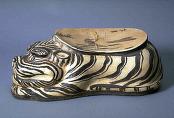| return
to Ford Library and Museum homepage |
|
Sung
(907-1279)
|
| next |
|
The collapse
of the T’ang brought chaos to China as numerous dynasties vied for
control. After 50 years of turmoil, one ruler emerged to re-unite the country.
Donning the yellow robe, he declared himself T’ai-tsu, Emperor of
the Sung. His dynasty would last 319 years and was one of China’s
most brilliant and attractive. |
| back |
|
| Shang
(1523-1027 BC) |
|
| Chou
(1027-221 BC) |
|
| Ch'in
(221-206 BC) |
|
| Han
(206 BC-AD 220) |
|
The Emperor
set aside military traditions and insisted on civilian control of his provinces,
government, and military. Civil service exams were revived, schools spread,
and literacy increased as new printing technology made books more widely
available. From this grew a new class well versed in the arts and intellectual
fields. |
 |
| Three
Kingdoms (220-581) |
|
| Sui
(581-618) |
|
| T'ang
(618-907) |
|
| Yüan
(1279-1368) |
|
| Ming
(1368-1644) |
|
The Sung boasted a welfare
state that included housing and care for the elderly, state hospitals, low-interest
loans for peasants, state orphanages, free pharmacies for the poor, filled
state granaries, and fire stations and libraries in the large cities. |
Tiger
shaped Pillow
1115 - 1234
Jin Period
ceramic
5 5/16 in. x 16 1/8 in.
Courtesy The University of Michgan Art Museum
|
| Ch'ing
(1644-1912) |
|
| Opening
the Door (1844-1911) |
|
| The
Period of Revolution (1912-1949) |
|
| Mao's
Dynasty (1949-1976) |
|
The Sung introduced
paper money in 1024. Checking accounts, bills of exchange, and promissory
notes soon followed. Increased yields in agriculture grew from the introduction
of new tools and techniques, and advances were made in the fields of mining
and manufacturing of ceramics as China moved from an agrarian to a mercantile
state. |
| Raising
the Bamboo Curtain (1972-1979) |
|
| Into
the Next Millennium (1979-) |
|
| |
| Other
countries took notice. From Japan to the Red Sea, countries sent fleets
to Chinese ports seeking trade. China, too, explored foreign ports. Her
ships, known as junks, were guided by compasses, and sported advanced capstans,
pivoting sails, and watertight compartments, making China’s fleet
the world’s greatest well into the fifteenth century. |
| In
this the age of China’s renaissance, advancements and innovations
flowed. The list is impressive. New methods of bridge building, canal lock-gates,
and water-powered clocks improved industry and the movement of people. Methods
of acupuncture and autopsies and a physician’s code of ethics were
codified. Great scientific publications were compiled on zoology and botany.
The field of philosophy swelled with the writings of neo-Confucians, and
the arts, too, saw striking advancements in the lyrical song and portrait
and landscape paintings. |
| The
peace that permitted these grand accomplishments was purchased at a high
price, as foreign lands to the north were paid large tributes. In time,
those barbarians became so powerful that they swept down on China, pushing
the Sung southward. |
| But
in an adjacent part of the world another ruler was forging remarkable achievements
of his own kind. The Mongol ruler Genghis Khan had by 1185 conquered central
Asia as far west as the Black Sea. By 1232 the Jurchen state in north China
fell to his pony soldiers. His son, Kublai, would defeat the Southern Sung
in 1279. |

